Influence of Compaction Methods on Properties of Roller-Compacted Concrete Pavement Wearing Surfaces
Abstract
1. Introduction
- Use of standard machines for asphalt paving (pavers, smooth steel, and tire rollers);
- The ability to be subjected to traffic loads much faster than in the case of classic concrete technology with the use of poured concrete, even 48 h after paving;
- Speed of the construction process—renovation including removal of the old surface takes up to 7 days and the speed of laying the new surface ranges from 60 to 120 m per hour;
- High availability of concrete plants.
2. Materials and Methods
2.1. Materials
- Mixing water for concrete in accordance with the EN 1008 standard [31].
- SiO2—4.18%;
- CaO—52.30%;
- MgO—0.42%;
- Fe2O3—1.28%;
- Al2O3—0.25%.
| Property | Test Method | Performance Properties/Category |
|---|---|---|
| Aggregate sizes (d/D) | EN 933-1 [33] | 0/2 |
| Grading | EN 933-1 [33] | GF85 |
| Fines content | EN 933-1 [33] | f3 |
| Apparent particle density ρa, Mg/m3 | EN 1097-6 [34] | 1.58 ± 0.10 |
| Total sulfur | EN 1744-1 [35] | ≤1.0 |
| Property | Test Method | Performance Properties/Category | ||
|---|---|---|---|---|
| Aggregate sizes (d/D) | EN 933-1 [33] | 2/8 | 8/16 | 16/22.4 |
| Grading | EN 933-1 [33] | GC90/15 | GC90/15 | GC90/15 |
| Tolerance of grading | EN 933-1 [33] | G20/17.5 | G20/15 | G20/15 |
| Flakiness index | EN 933-3 [36] | Fl15 | Fl15 | Fl10 |
| Grain density: | EN 1097-6 [34] | |||
| 2.674 | 2.684 | 2.681 | |
| 2.646 | 2.656 | 2.652 | |
| 2.656 | 2.666 | 2.663 | |
| Fines content | EN 933-1 [33] | f2 | f2 | f2 |
| Resistance to fragmentation, Los Angeles test method | EN 1097-2 [37] | LA25 | LA25 | LA25 |
| Freeze–thaw resistance | EN 1367-1 [38] | F1 | F1 | F1 |
| Resistance to polishing | EN 1097-8 [39] | PSV44 | PSV44 | PSV44 |
| Loose bulk density ρo, Mg/m3 | EN 1097-3 [40] | 1.628 | 1.708 | 1.680 |
2.2. Methods
2.2.1. Experimental Methodology
- Compressive strength after 7 and 28 days (MPa) in accordance with the EN 12390-3 standard [42];
- Bulk density (g/cm3) on 28-day strength test specimens with the use of the geometric method for cube and cylindrical specimens, and with a sand volume meter for specimens drilled in the slab in accordance to the ASTM D 1556 [43];
- Percent bulk density (%) in relation to the modified Proctor method.
2.2.2. Methods for the Design of the RCC Mixture
2.2.3. Methods for Preparing the RCC Mixture for Testing
2.2.4. Methods for Producing RCC Test Specimens
- Proctor rammer A (2.5 kg), compaction in 3 layers with 56 blows per layer;
- Proctor rammer B (4.5 kg), compaction in 3 layers with 56 blows per layer;
- Proctor rammer B (4.5 kg), compaction in 5 layers with 56 blows per layer.
- In the first variant, six static passes were used for compaction, simulating the operation of a heavy roller;
- In the second, the first two passes used static pressing force, while the next four included vibration.
2.2.5. Compressive Strength and Density Tests
3. Results
3.1. Roller-Compacted Concrete Mix Design
3.2. Compressive Strength and Bulk Density Tests
- —characteristic compressive strength of concrete after 28 days;
- —average compressive strength of concrete;
- —a single test result of concrete compressive strength determined on a cube specimen.
3.3. Statistical Analysis
4. Discussion
5. Conclusions
- The shape of the Proctor samples (cylindrical, cubic) did not significantly affect the strength of RCC samples;
- Samples produced in the slab compactor with the vibration setting performed similarly to the Proctor samples in terms of compressive strength;
- Different compaction methods produced more significant differences in bulk densities than in the compressive strengths of the samples;
- Comparable bulk densities were obtained in cylindrical and cubic molds when the same Proctor rammer was used;
- Only the slab compactor samples prepared without the use of vibration did not meet the required compaction of 98%.
- Decreasing the number of layers in which the material is compacted from 5 to 3;
- Utilizing the 2.5 kg rammer;
- A change in compaction method to the one utilizing a slab compactor with a vibration setting.
Author Contributions
Funding
Institutional Review Board Statement
Informed Consent Statement
Data Availability Statement
Acknowledgments
Conflicts of Interest
References
- Stępień, J.; Maciejewski, K. Using Reclaimed Cement Concrete in Pavement Base Mixes with Foamed Bitumen Produced in Cold Recycling Technology. Materials 2022, 15, 5175. [Google Scholar] [CrossRef] [PubMed]
- Chomicz-Kowalska, A.; Stepien, J. Cost and Eco-Effective Cold In-Place Recycled Mixtures with Foamed Bitumen during the Reconstruction of a Road Section under Variable Load Bearing Capacity of the Subgrade. Procedia Eng. 2016, 161, 980–989. [Google Scholar] [CrossRef][Green Version]
- Mackiewicz, P.; Szydło, A.; Krawczyk, B. Influence of the Construction Technology on the Texture and Roughness of Concrete Pavements. Roads Bridges-Drog. I Mosty 2018, 17, 111–126. [Google Scholar] [CrossRef]
- Kim, Y.S. Roller-Compacted Concrete Shoulder Construction on Interstate Highway in Georgia. Transp. Res. Rec. J. Transp. Res. Board 2007, 2040, 71–79. [Google Scholar] [CrossRef]
- Zhuo, M.-Y.; Chen, J.-C.; Zhang, R.-L.; Zhan, Y.-K.; Huang, W.-S. Seepage Prediction Model for Roller-Compacted Concrete Dam Using Support Vector Regression and Hybrid Parameter Optimization. Water 2023, 15, 3511. [Google Scholar] [CrossRef]
- Zhang, W.; Li, H.; Shi, D.; Shen, Z.; Zhao, S.; Guo, C. Determination of Safety Monitoring Indices for Roller-Compacted Concrete Dams Considering Seepage–Stress Coupling Effects. Mathematics 2023, 11, 3224. [Google Scholar] [CrossRef]
- Chen, X.; Xu, P.; Liu, X.; Su, C. Comprehensive Evaluation Method for the Safety State of RCC Dams Based on Interval Number Theory. Water 2023, 15, 2089. [Google Scholar] [CrossRef]
- Mickevič, R.; Vaitkus, A. Application of Roller-Compacted Concrete in Freight Terminals. Moksl. Liet. Ateitis 2020, 12, 1–5. [Google Scholar] [CrossRef]
- Vahedifard, F.; Nili, M.; Meehan, C.L. Assessing the Effects of Supplementary Cementitious Materials on the Performance of Low-Cement Roller Compacted Concrete Pavement. Constr. Build. Mater. 2010, 24, 2528–2535. [Google Scholar] [CrossRef]
- Debbarma, S.; Ransinchung, R.N.G.D. Achieving Sustainability in Roller Compacted Concrete Pavement Mixes Using Reclaimed Asphalt Pavement Aggregates–State of the Art Review. J. Clean. Prod. 2021, 287, 125078. [Google Scholar] [CrossRef]
- Debbarma, S.; Ransinchung, R.N.G.D.; Singh, S. Feasibility of Roller Compacted Concrete Pavement Containing Different Fractions of Reclaimed Asphalt Pavement. Constr. Build. Mater. 2019, 199, 508–525. [Google Scholar] [CrossRef]
- Meddah, A.; Beddar, M.; Bali, A. Use of Shredded Rubber Tire Aggregates for Roller Compacted Concrete Pavement. J. Clean. Prod. 2014, 72, 187–192. [Google Scholar] [CrossRef]
- Miller, R.E. Compaction of Roller-Compacted Concrete; American Concrete Institute: Farmington Hills, MI, USA, 2000. [Google Scholar]
- Pulecio-Díaz, J.; Sol-Sánchez, M.; Moreno-Navarro, F. Effects of Relative Humidity and Temperature on the Drying Shrinkage of Roller-Compacted Concrete Pavements. Infrastructures 2024, 9, 22. [Google Scholar] [CrossRef]
- Pulecio-Díaz, J.; Sol-Sánchez, M.; Moreno-Navarro, F. Influence of Service Conditions and Mix Design on the Physical–Mechanical Properties of Roller-Compacted Concrete for Pavement. Materials 2024, 17, 552. [Google Scholar] [CrossRef] [PubMed]
- Pulecio-Díaz, J.; Sol-Sánchez, M.; Moreno-Navarro, F. Prediction of the Physical-Mechanical Properties of Roller-Compacted Concrete Pavements under Different Service and Mix Conditions Based on Cement and Water Content. Materials 2024, 17, 549. [Google Scholar] [CrossRef] [PubMed]
- Seav, N.; Kim, K.S.; Kim, J.H.; Lee, S.W.; Kim, Y.K. Effects of Roller Compacted Concrete Incorporating Coal Bottom Ash as a Fine Aggregate Replacement. Sustainability 2023, 15, 11420. [Google Scholar] [CrossRef]
- Tayabji, S. Designers’s Guide for UFGS 32 13 16.16 Roller Compacted Concrete (RCC) Pavement; BiblioGov: Golden, CO, USA, 2010. [Google Scholar]
- Harrington, D.; Abdo, F.; Adaska, W.; Hazaree, C. Guide for Roller-Compacted Concrete Pavements; Institute for Transportation Iowa State University: Ames, IA, USA, 2010; p. 104. [Google Scholar]
- EN 12390-2:2019; Testing Hardened Concrete—Part 2: Making and Curing Specimens for Strength Tests. European Committee for Standardization (CEN): Pilsen, Czech Republic, 2019.
- Liu, Y.; Wang, B.; Fan, Y.; Yu, J.; Shi, T.; Zhou, Y.; Song, Y.; Xu, G.; Xiong, C.; Zhou, X. Effects of Reactive MgO on Durability and Microstructure of Cement-Based Materials: Considering Carbonation and PH Value. Constr. Build. Mater. 2024, 426, 136216. [Google Scholar] [CrossRef]
- He, L.; Chen, B.; Liu, Q.; Chen, H.; Li, H.; Chow, W.T.; Tang, J.; Du, Z.; He, Y.; Pan, J. A Quasi-Exponential Distribution of Interfacial Voids and Its Effect on the Interlayer Strength of 3D Printed Concrete. Addit. Manuf. 2024, 89, 104296. [Google Scholar] [CrossRef]
- EN 13286-50; Unbound and Hydraulically Bound Mixtures—Part 50: Method for the Manufacture of Test Specimens of Hydraulically Bound Mixtures Using Proctor Equipment or Vibrating Table Compaction. Comité Européen de Normalisation (CEN): Brussels, Belgium, 2005.
- Selvam, M.; NSSP, K.; Kannan, K.R.; Singh, S. Assessing the Effect of Different Compaction Mechanisms on the Internal Structure of Roller Compacted Concrete. Constr. Build. Mater. 2023, 365, 130072. [Google Scholar] [CrossRef]
- Şengün, E.; Alam, B.; Shabani, R.; Yaman, I.O. The Effects of Compaction Methods and Mix Parameters on the Properties of Roller Compacted Concrete Mixtures. Constr. Build. Mater. 2019, 228, 116807. [Google Scholar] [CrossRef]
- Harat, K.; Woyciechowski, P. Roller Compacted Concrete Mix Design and Usefulness for Road Construction in Poland. In Proceedings of the Dni betonu 2012, Wisła, Poland, 8–10 October 2012; pp. 1–12. [Google Scholar]
- Amer, N.; Delatte, N.; Storey, C. Using Gyratory Compaction to Investigate Density and Mechanical Properties of Roller-Compacted Concrete. Transp. Res. Rec. 2003, 1834, 77–84. [Google Scholar] [CrossRef]
- EN 197-1; Cement—Part 1: Composition, Specifications and Conformity Criteria for Common Cements. European Committee for Standardization (CEN): Brussels, Belgium, 2012.
- EN 196-1; Methods of Testing Cement—Part 1: Determination of Strength. European Committee for Standardization (CEN): Brussels, Belgium, 2019.
- EN 12620+A1; Aggregates for Concrete. European Committee for Standardization (CEN): Brussels, Belgium, 2008.
- EN 1008; Mixing Water for Concrete—Specification for Sampling, Testing and Assessing the Suitability of Water, Including Water Recovered from Processes in the Concrete Industry, as Mixing Water for Concrete. European Committee for Standardization (CEN): Brussels, Belgium, 2004.
- EN 206; Concrete—Specification, Performance, Production and Conformity. European Committee for Standardization (CEN): Brussels, Belgium, 2016.
- EN 933-1; Tests for Geometrical Properties of Aggregates—Part 1: Determination of Particle Size Distribution—Sieving Method. Comité Européen de Normalisation (CEN): Brussels, Belgium, 2012.
- EN 1097-6; Tests for Mechanical and Physical Properties of Aggregates—Part 6: Determination of Particle Density and Water Absorption. Comité Européen de Normalisation (CEN): Brussels, Belgium, 2022.
- EN 1744-1+A1; Tests for Chemical Properties of Aggregates—Part 1: Chemical Analysis. Comité Européen de Normalisation (CEN): Brussels, Belgium, 2014.
- EN 933-3; Tests for Geometrical Properties of Aggregates—Part 3: Determination of Particle Shape—Flakiness Index. Comité Européen de Normalisation (CEN): Brussels, Belgium, 2012.
- EN 1097-2; Tests for Mechanical and Physical Properties of Aggregates—Part 2: Methods for the Determination of Resistance to Fragmentation. Comité Européen de Normalisation (CEN): Brussels, Belgium, 2020.
- EN 1367-1; Tests for Thermal and Weathering Properties of Aggregates—Part 1: Determination of Resistance to Freezing and Thawing. European Committee for Standardization (CEN): Brussels, Belgium, 2007.
- EN 1097-8; Tests for Mechanical and Physical Properties of Aggregates—Part 8: Determination of the Polished Stone Value. European Committee for Standardization (CEN): Brussels, Belgium, 2020.
- EN 1097-3; Tests for Mechanical and Physical Properties of Aggregates—Part 3: Determination of Loose Bulk Density and Void. European Committee for Standardization (CEN): Brussels, Belgium, 1998.
- EN 12697-33; Bituminous Mixtures. Test Methods for Hot Mix Asphalt—Specimen Prepared by Roller Compactor. Comité Européen de Normalisation (CEN): Brussels, Belgium, 2019.
- EN 12390-3; Testing Hardened Concrete—Part 3: Compressive Strength of Test Specimens. European Committee for Standardization (CEN): Brussels, Belgium, 2019.
- ASTM D 1556; Standard Test Method for Density and Unit Weight of Soil in Place by Sand-Cone Method. European Committee for Standardization (CEN): Brussels, Belgium, 2015.
- Tayabji, S.D. Roller Compacted Concrete Pavements Design and Construction; American Concrete Institute: Washington, DC, USA, 1995. [Google Scholar]
- Tayabji, S.D. Report on Roller-Compacted Concrete Pavements; American Concrete Institute: Farmington Hills, MI, USA, 1995. [Google Scholar]
- EN 13286-2; Unbound and Hydraulically Bound Mixtures—Part 2: Test Methods for Laboratory Dry Density and Water Content—Proctor Compaction. European Committee for Standardization (CEN): Brussels, Belgium, 2010.
- Luhr, D.R. Frost Durability of Roller-Compacted Concrete Pavements: Research Synopsis; Portland Cement Association: Skokie, IL, USA, 2006. [Google Scholar]
- ASTM D 1557; Standard Test Methods for Laboratory Compaction Characteristics of Soil Using Modified Effort. European Committee for Standardization (CEN): Brussels, Belgium, 2000.
- Sabnis, G.M.; Mirza, S.M. Size Effects in Model Concretes? J. Struct. Div. 1979, 105, 1007–1020. [Google Scholar] [CrossRef]
- Li, M.; Hao, H.; Shi, Y.; Hao, Y. Specimen Shape and Size Effects on the Concrete Compressive Strength under Static and Dynamic Tests. Constr. Build. Mater. 2018, 161, 84–93. [Google Scholar] [CrossRef]
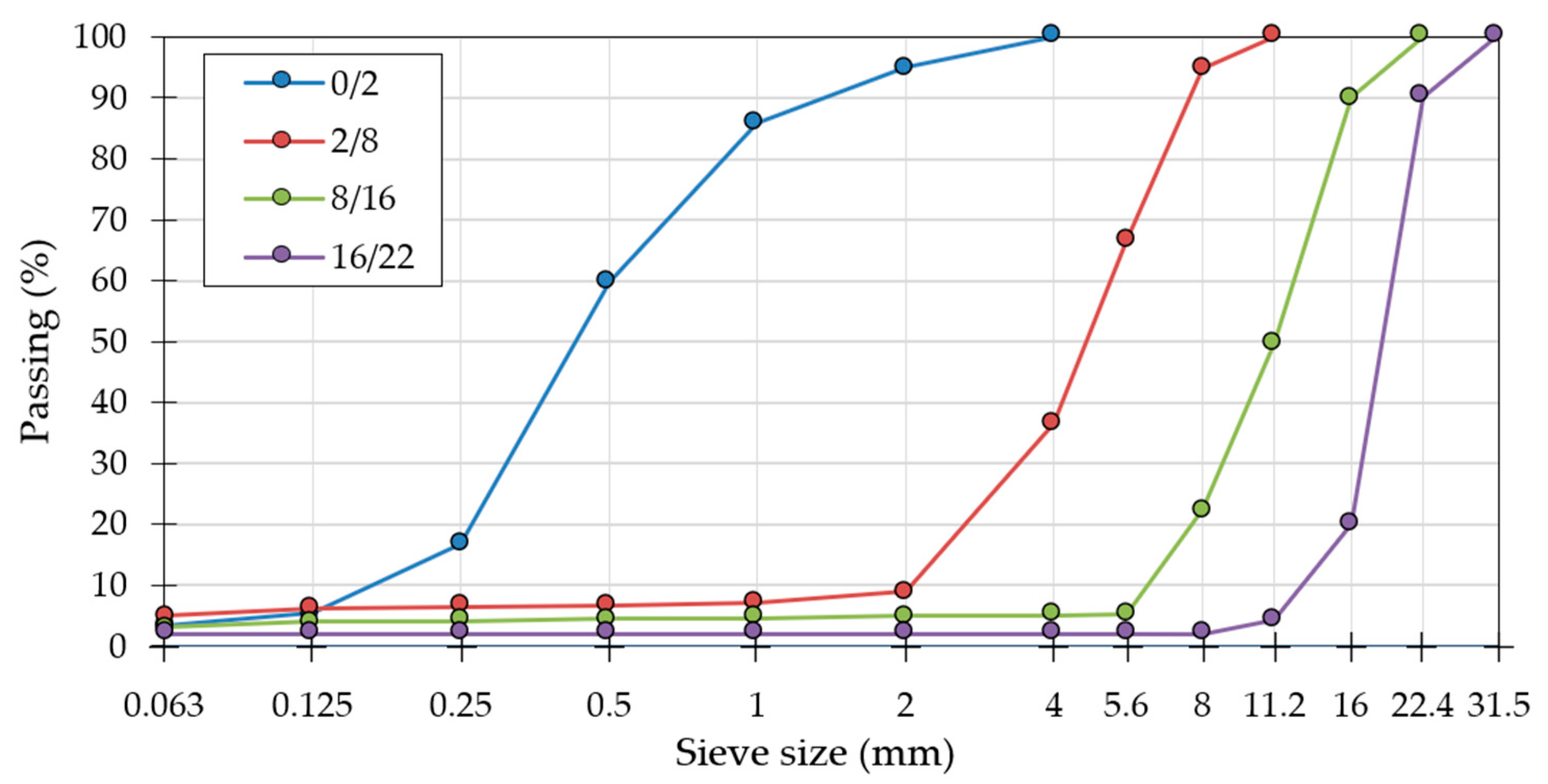
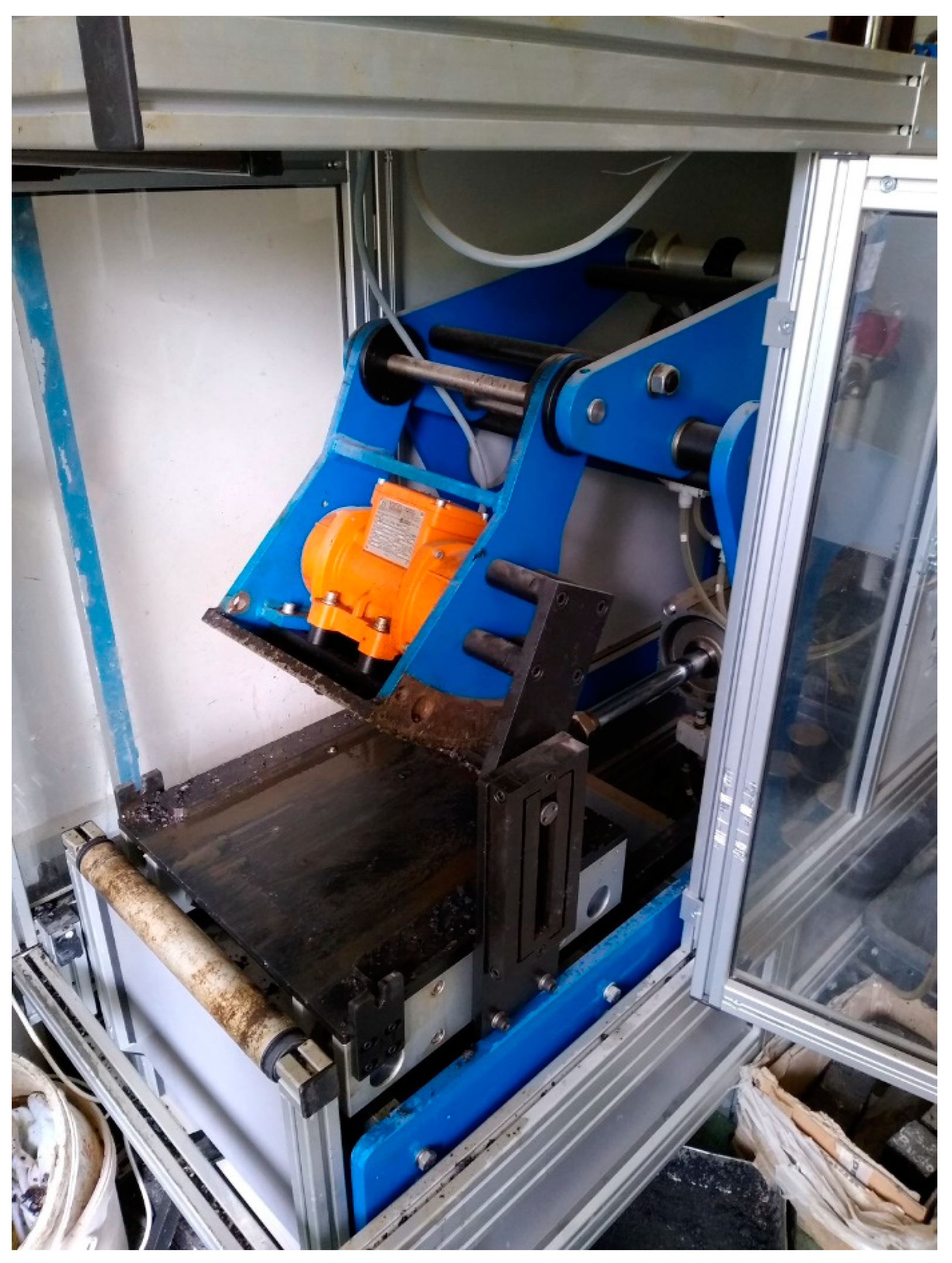


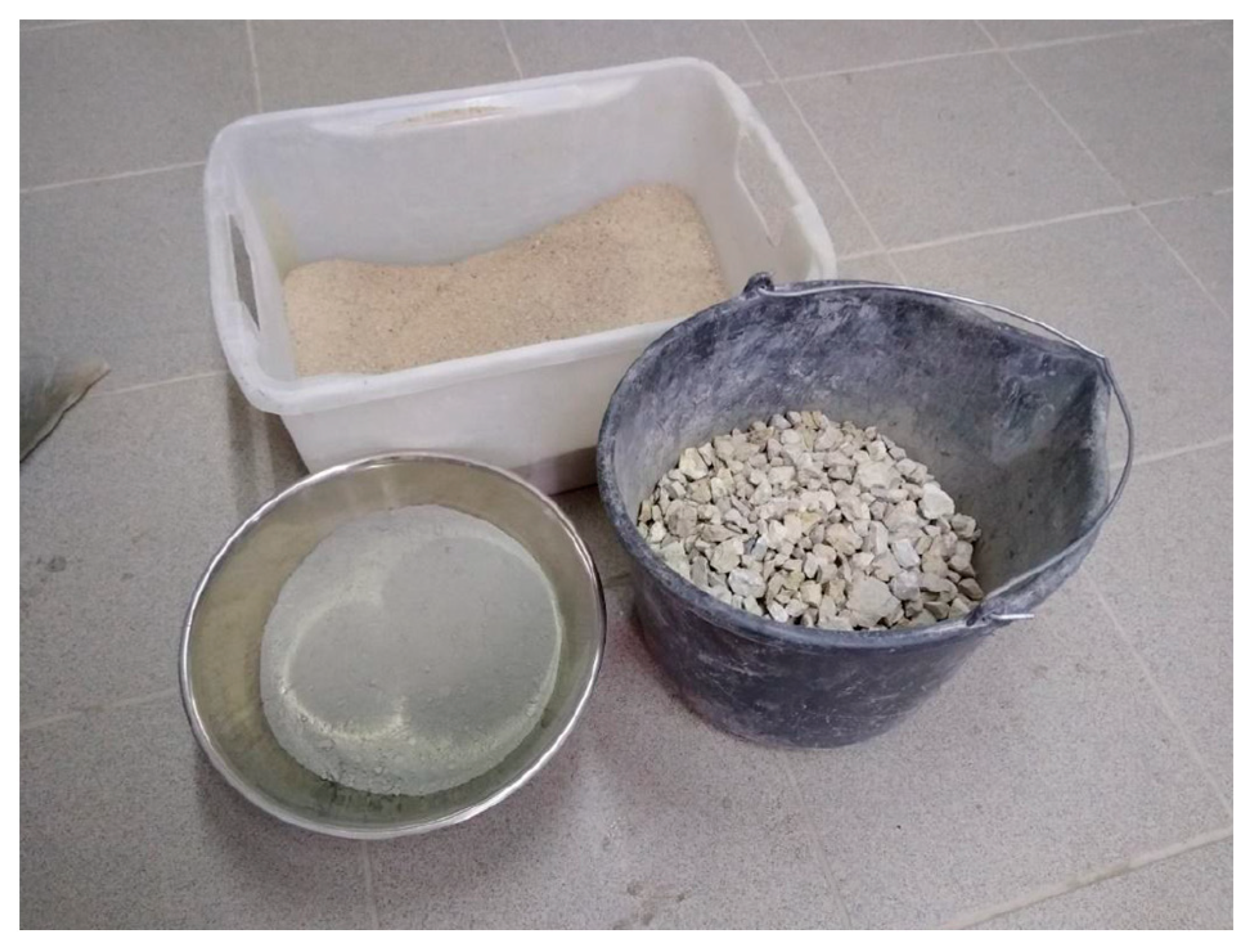
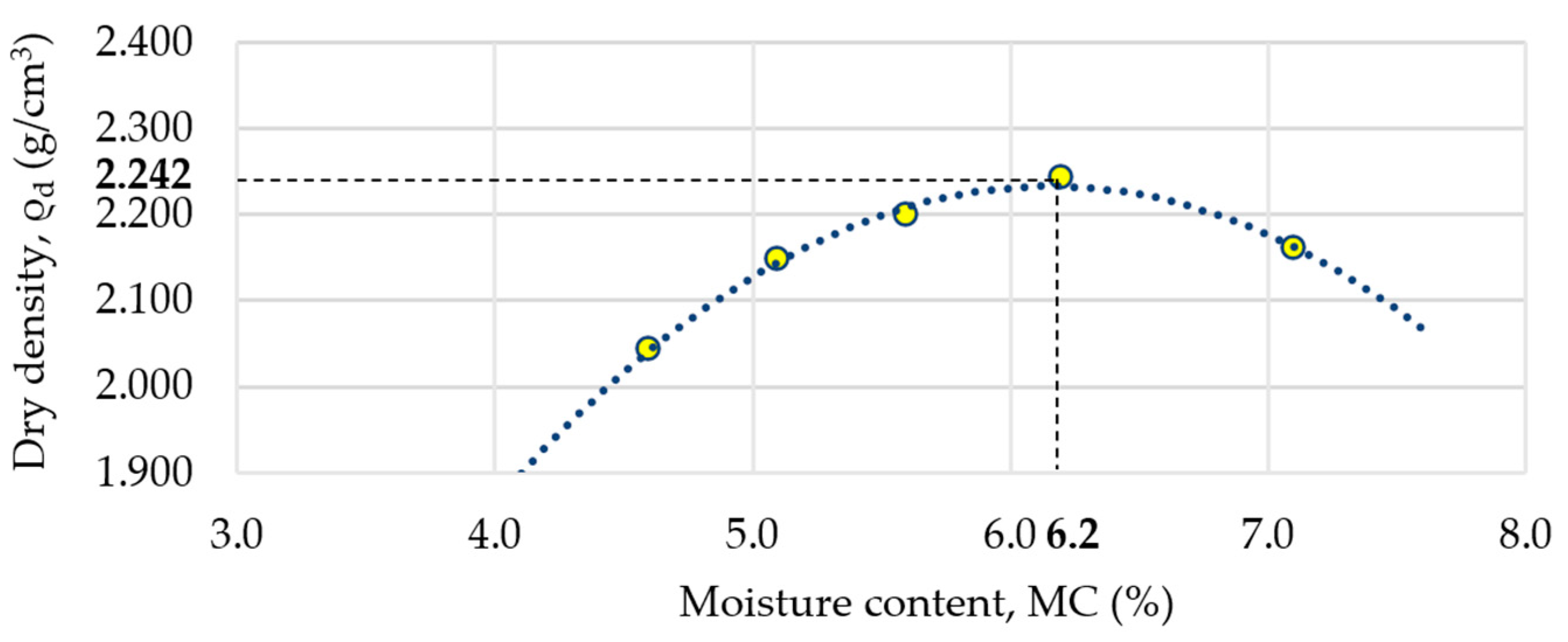


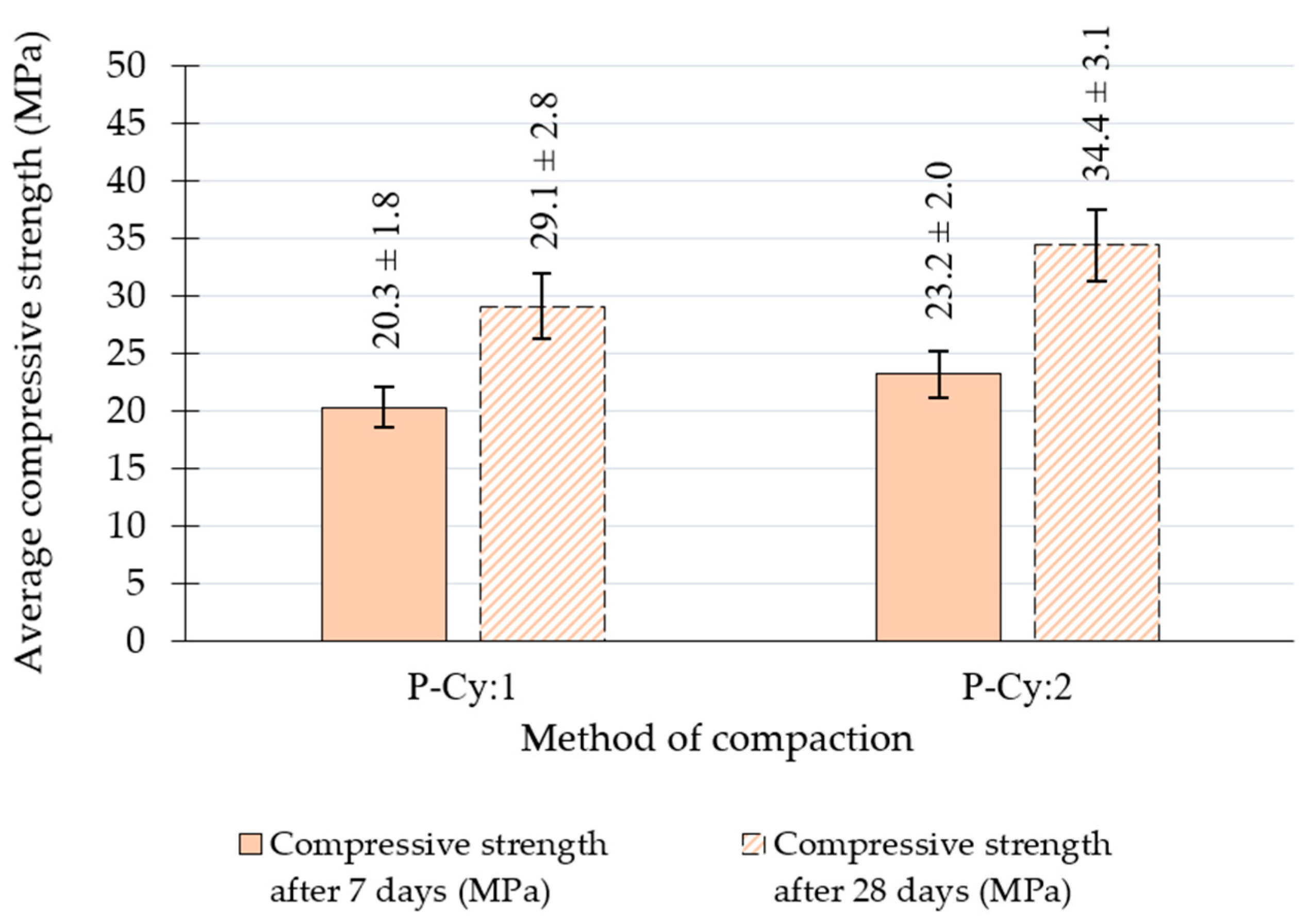

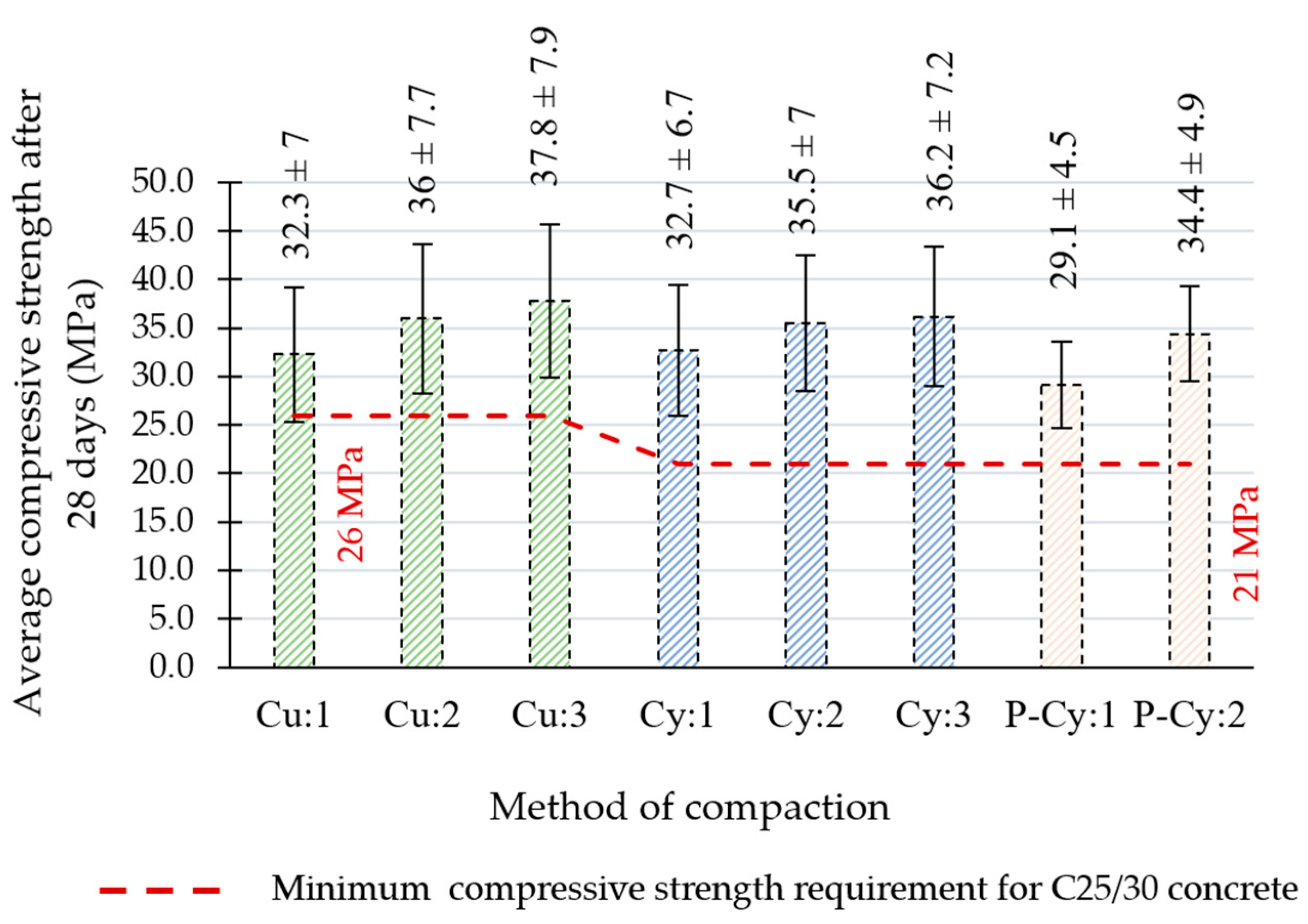
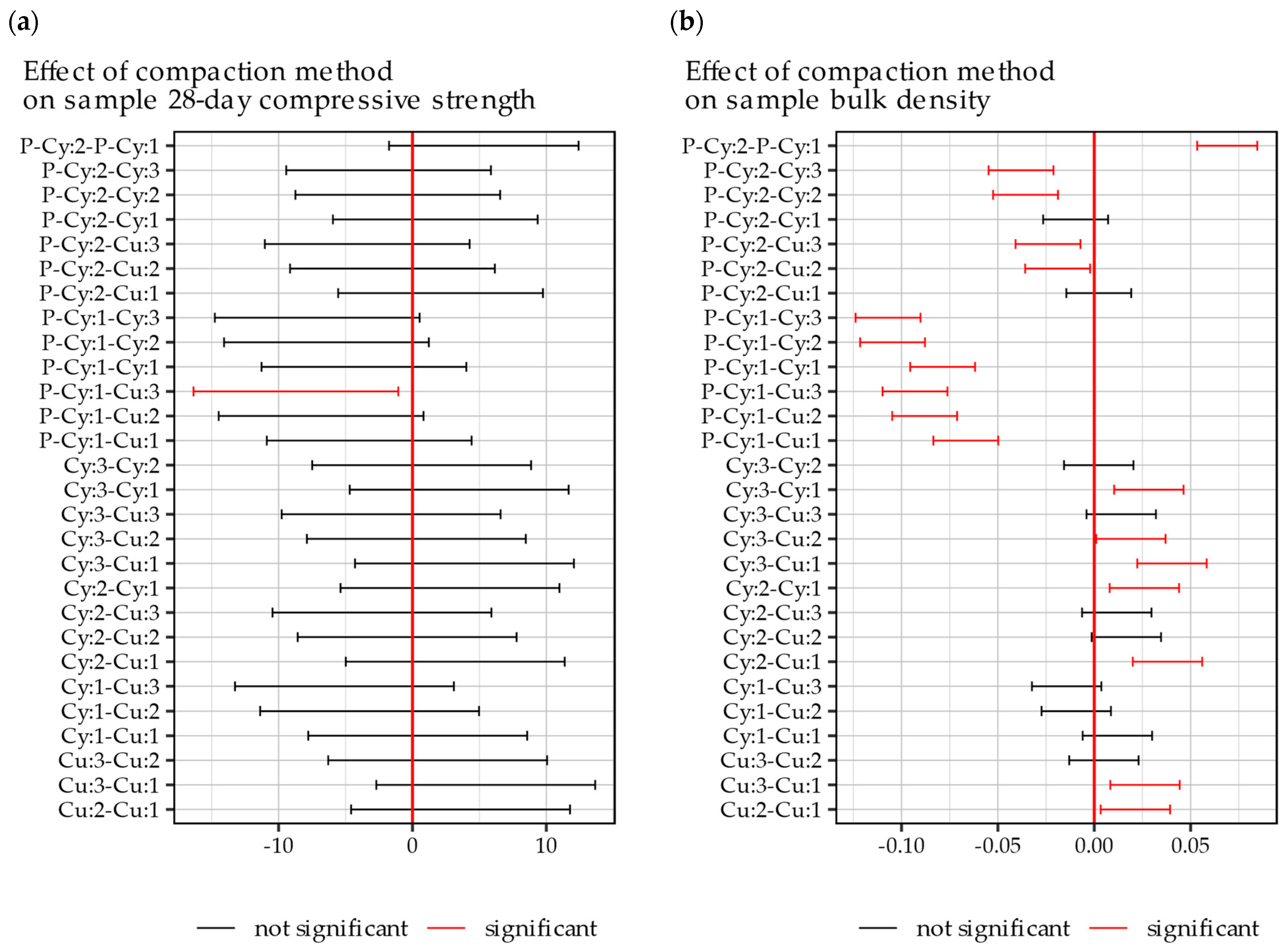

| Proctor Mould | Diameter (mm) | Height (mm) | Thickness | |
|---|---|---|---|---|
| Wall | Base Plate | |||
| A | 100.0 ± 1.0 | 120.0 ± 1.0 | 7.5 ± 0.5 | 11.0 ± 0.5 |
| B | 150.0 ± 1.0 | 120.0 ± 1.0 | 9.0 ± 0.5 | 14.0 ± 0.5 |
| C | 250.0 ± 1.0 | 200.0 ± 1.0 | 14.0 ± 0.5 | 20.0 ± 0.5 |
| Rammer | Essential Requirements | ||
|---|---|---|---|
| Mass of Rammer (kg) | Diameter of the Base (mm) | Height of Fall (mm) | |
| A | 2.50 ± 0.02 | 50.0 ± 0.5 | 305 ± 3 |
| B | 4.50 ± 0.04 | 50.0 ± 0.5 | 457 ± 3 |
| C | 15.00 ± 0.04 | 125.0 ± 0.5 | 600 ± 3 |
| Specimen No. (Markings) | Mold Weight | Mold Weight with Specimen | Mold Volume | Moisture Content | Bulk Density | Dry Density |
|---|---|---|---|---|---|---|
| (g) | (g) | (mL) | (%) | (g/cm3) | (g/cm3) | |
| P1 | 9641.0 | 14171.9 | 2120.6 | 4.6 | 2.137 | 2.043 |
| P2 | 9641.0 | 14428.4 | 2120.6 | 5.1 | 2.258 | 2.148 |
| P3 | 9641.0 | 14563.6 | 2120.6 | 5.6 | 2.321 | 2.198 |
| P4 | 9641.0 | 14689.2 | 2120.6 | 6.2 | 2.381 | 2.242 |
| P5 | 9641.0 | 14546.5 | 2120.6 | 7.1 | 2.313 | 2.160 |
| Ingredients of the Mix | Quantity (kg/m3) | Percentage |
|---|---|---|
| Natural sand, 0/2 mm | 785 | 32.8 |
| Limestone, 2/8 mm | 628 | 26.3 |
| Limestone, 8/16 mm | 354 | 14.8 |
| Limestone, 16/22.4 mm | 196 | 8.2 |
| CEM II/B-V cement | 280 | 11.7 |
| Water | 148 | 6.2 |
| Proctor Cubic Specimens 150 mm in Side | |||||
|---|---|---|---|---|---|
| Method of Compaction | Rammer Type | Number of Layers | Number of Blows | Increase in the Average Compressive Strength After 28 Days in Relative to Result After 7 Days | Average Bulk Density |
| (kg) | (-) | (-) | (%) | (g/cm3) | |
| Tamping (Cu:1) | 2.5 | 3 | 56 | 37.4 | 2.348 |
| Tamping (Cu:2) | 4.5 | 3 | 56 | 44.6 | 2.369 |
| Tamping (Cu:3) | 4.5 | 5 | 56 | 51.2 | 2.374 |
| Proctor Cylindrical Specimens 160 × 160 mm | |||||
|---|---|---|---|---|---|
| Method of Compaction | Rammer Type | Number of Layers | Number of Blows | Increase in the Average Compressive Strength After 28 Days in Relative to Result After 7 Days | Average Bulk Density |
| (kg) | (-) | (-) | (%) | (g/cm3) | |
| Tamping (Cy:1) | 2.5 | 3 | 56 | 48.0 | 2.360 |
| Tamping (Cy:2) | 4.5 | 3 | 56 | 46.7 | 2.385 |
| Tamping (Cy:3) | 4.5 | 5 | 56 | 47.2 | 2.388 |
| 100 × 100 mm Specimens Drilled from the Slab | ||||
|---|---|---|---|---|
| Method of Compaction | Number of Static Passes | Number of Passes with Vibration | Increase in the Average Compressive Strength After 28 Days in Relative to Result After 7 Days | Average Bulk Density |
| (-) | (-) | (%) | (g/cm3) | |
| Slab compactor (P-Cy:1) | 6 | 0 | 43.3 | 2.282 |
| Slab compactor (P-Cy:2) | 2 | 4 | 48.3 | 2.351 |
| Independent Variable | 28-Day Compressive Strength (MPa) | Bulk Density (Mg/m3) | ||
|---|---|---|---|---|
| Effect | Estimate | p-Value | Estimate | p-Value |
| Intercept | 32.303 | <0.001 | 2.348 | <0.001 |
| Cu:2 | 3.593 | 0.151 | 0.021 | <0.001 |
| Cu:3 | 5.477 | 0.035 | 0.026 | <0.001 |
| Cy:1 | 0.393 | 0.872 | 0.012 | 0.035 |
| Cy:2 | 3.197 | 0.199 | 0.038 | <0.001 |
| Cy:3 | 3.883 | 0.123 | 0.040 | <0.001 |
| P-Cy:1 | -3.231 | 0.167 | -0.067 | <0.001 |
| P-Cy:2 | 2.099 | 0.362 | 0.002 | 0.642 |
Disclaimer/Publisher’s Note: The statements, opinions and data contained in all publications are solely those of the individual author(s) and contributor(s) and not of MDPI and/or the editor(s). MDPI and/or the editor(s) disclaim responsibility for any injury to people or property resulting from any ideas, methods, instructions or products referred to in the content. |
© 2025 by the authors. Licensee MDPI, Basel, Switzerland. This article is an open access article distributed under the terms and conditions of the Creative Commons Attribution (CC BY) license (https://creativecommons.org/licenses/by/4.0/).
Share and Cite
Stępień, J.; Chomicz-Kowalska, A.; Tutaj-Dudała, M.; Dudała, M.; Maciejewski, K.; Ramiączek, P.; Iwański, M.M. Influence of Compaction Methods on Properties of Roller-Compacted Concrete Pavement Wearing Surfaces. Materials 2025, 18, 492. https://doi.org/10.3390/ma18030492
Stępień J, Chomicz-Kowalska A, Tutaj-Dudała M, Dudała M, Maciejewski K, Ramiączek P, Iwański MM. Influence of Compaction Methods on Properties of Roller-Compacted Concrete Pavement Wearing Surfaces. Materials. 2025; 18(3):492. https://doi.org/10.3390/ma18030492
Chicago/Turabian StyleStępień, Justyna, Anna Chomicz-Kowalska, Magdalena Tutaj-Dudała, Michał Dudała, Krzysztof Maciejewski, Piotr Ramiączek, and Mateusz Marek Iwański. 2025. "Influence of Compaction Methods on Properties of Roller-Compacted Concrete Pavement Wearing Surfaces" Materials 18, no. 3: 492. https://doi.org/10.3390/ma18030492
APA StyleStępień, J., Chomicz-Kowalska, A., Tutaj-Dudała, M., Dudała, M., Maciejewski, K., Ramiączek, P., & Iwański, M. M. (2025). Influence of Compaction Methods on Properties of Roller-Compacted Concrete Pavement Wearing Surfaces. Materials, 18(3), 492. https://doi.org/10.3390/ma18030492







